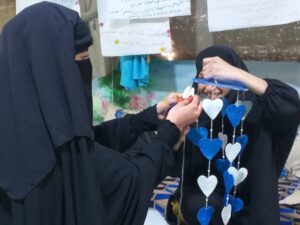Contributors: Dr. Nour Abu-Assab, Dr. Nof Nasser-Eddin
Executive summary
Eight years into the Syrian crisis, Syrian civil society is still considered relatively nascent in comparison to civil society actors in neighboring countries. Despite international agencies and donor governments repeatedly highlighting the importance of involving women in civil society organizing, the voices of Syrian women in civil society and in the political arena are considered largely ‘absent’.
However, the absence of such voices does not necessarily mean that Syrian women are not involved in civil society activism. The importance of this research derives above all from the importance of including women’s voices in civil society. With the absence of their voices, women’s needs, opinions, and perspectives are side-lined. This report has highlighted challenges to women’s involvement in Syrian civil society. The main problems can be divided into internal and external categories:
Internal factors
Lack of gender awareness
There is a general lack of awareness within CSOs in relation to the meaning of gender and how to make their organizations gender-sensitive. It has become apparent that this lack of awareness is often reflected in organizational policies, which are often lacking in relation to addressing violence, bullying, and harassment within the workplace.
Lack of internal policies and regulations
Research revealed that the lack of internal policies and regulations is very much related to the security situation in CSOs’ areas of operation. CSOs in more stable locations in terms of security were more likely to have internal policies and regulations in place. In areas where there is a lack of security CSOs seem to be responsive and flexible in their approach depending on the changing needs of their areas.
Immaturity of Civil Society Organisations
In addition to the security situation, donor priorities often prevent internal organizational development work from taking place. Donors’ focus on funding activities with short-term results limits CSOs’ ability to develop. These policies can affect the involvement of women, as CSOs remain unable to improve internal conditions, which could result in an increase in women’s involvement in CSOs.
Financial and economic inequalities
Data showed that the management of finances influences women’s access to jobs, and compromises their needs. Financial and economic inequalities affecting women’s involvement are not related to gender pay gap issues but are rather manifested in inequalities related to (1) access to employment, (2) position at the CSO, and (3) the lack of special provisions to accommodate for women’s needs, including maternity leaves and childcare.
Recreating gendered hierarchies
Based on this research, CSOs reinforce gender hierarchies in the workplace. These hierarchies operate on different levels, and these include (1) decision making, (2) positions and ranking, and (3) numbers and representation. Women are often excluded from decision-making positions unless these positions were at an organization that focuses solely on gender or women’s rights. In addition to that, men are often granted leadership positions in the majority of organizations. Often in organizations headed by men, women find themselves completely excluded from major decision-making conversations.
External factors
Funding restrictions
There is a misconception that major funding is being poured into women’s organizations and organizations that focus on violence against women. Research has revealed that in fact, only 0.5 percent of international funding went into projects targeting women. In addition to that, the majority of those who work on gender and women-related issues are volunteers. Funding restrictions also influence to a great degree organizations’ ability to accommodate women’s needs, as they rely on activity-based projects.
Lack of context-specific interventions
Data also showed that many donors over the past few years have been trying to make their projects more gender-inclusive. Instead of funding women-led organizations, donors have systematically added gender components in projects that are being implemented by male-led organizations. This reflects a massive inequality in funding allocations specifically relevant to the needs of women.
Security situation
The security situation has emerged as an important variable in determining the level of gender sensitivity in Syrian CSOs. It has become apparent through research that the operations of CSOs are largely dependent on the situation and the context of their locations. In some countries for example legal restrictions meant limitations on CSOs activities. This has also meant that some organizations were more likely to have more gender-sensitive policies than others, or operated more flexibly to adapt to the local context.
Social context
Data has shown that the social context in neighboring countries and in the different Syrian areas can have a great influence on women’s involvement in CSOs. There are social values that hinder women’s involvement in CSOs; however, these are different in different contexts.


